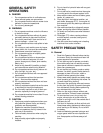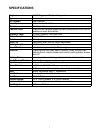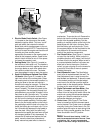9
c. Avoid turning when going downhill, traction
is at a minimum going downhill.
d. Do not operate with discharge side of the
mower toward streets, buildings, play-
grounds, parking lots, other machines, ani-
mals, and other people.
e. Avoid operation or use extreme care if the
traction surface is wet, unstable, or slip-
pery.
f. Use extra care when grass clippings,
leaves, pine needles, or debris are present
as traction can be reduced.
g. Slow-down before turning and come to a
complete stop before any zero turn maneu-
ver.
h. Do not stop machine or park machine over
combustible materials such as dry grass,
leaves, debris, etc.
3. To Mow Grass and Produce a Striped Pat-
tern
a. Pick a point on the opposite side of the
area to be mowed (post, tree, shrub, etc.).
b. If on an hillside, start at the bottom so that
the turns are uphill rather than downhill.
c. Align the mower so as to head directly
toward the object on the far side.
d. Slowly increase the speed of the machine
to match cutting conditions, terrain, and
operator familiarity with the controls and
keep the machine headed directly toward
the alignment object. Do not go fast as to
reduce cut quality or to be uncomfortable
in controlling the speed and direction of the
machine.
e. When approaching the other end of a strip,
slow down or stop before turning. A U-turn
is recommended unless a zero turn is
required. The speed of a U-turn that will
allow for machine controllability and mini-
mal turf defacement will be dependent on
several factors including: the speed of the
turn, the radius of the turn, the tire tread
pattern, the traction coefficient of the tire to
the traction surface, the slope of the trac-
tion surface.
f. Remember, a zero turn requires that the
forward or reverse travel of the machine be
stopped prior to the initiation of the turn or
severe turf defacement can occur.
g. To prevent rutting or grooving of the turf,
change the direction that the strips are
mowed by approximately 45 degrees the
next and each subsequent time that the
area is mowed.
B.Controls
1.
Engine Ignition and Start Switch:
(See Fig-
ure 1.) Located on the instrument housing
below the right side of the operator’s seat.
When the key is inserted and turned clock-
wise, 45 degrees, the ignition circuit is closed.
Turning the switch further against spring pres-
sure starts the engine. The engine will only
start if the blade clutch switch is in the “off”
position, the parking brake is engaged and
the left and right steering levers are in the
neutral, opened-out position. The key should
always be removed from the switch if the
operator leaves the mower’s seat.
2.
Engine Throttle Control:
(See Figure 2.)
Located on the left side of the mower next to
the operator’s seat. Moving the throttle control
from the rear to the front will increase the
engine speed from slow to fast.
3.
Left and Right Steering Levers:
(See Figure
3.) These hinged levers open out to the side in
the neutral position to permit the operator to
be seated or to leave the mower’s seat. The
operator, when seated, can pull the levers up
to the operating position, a comfortable fore-
arm’s length away. These levers control all of
the movements of the mower. Pushing both
levers forward causes the mower to move for-
ward. Pulling both levers back causes the
mower to move backward. Pushing one lever
ahead of the other lever causes the traction
wheel on the side where the lever is ahead to
rotate faster than the other traction wheel,
making the mower turn toward the side where
the lever is behind. When one lever is pushed
forward and the other lever pulled back the
same amount, one traction wheel will turn in
reverse and the mower will turn within its own
length.
In order to start the engine, both steering
levers must be opened out to the side in the
neutral position; the parking brake must be
engaged; and the blade clutch switch must be
“off”. However, once the engine starts, the
parking brake must be released before the
operator places the steering levers into the
operating position or the engine will
automatically shut off.
Note:
The Steering Lever will return toward
neutral when released, but they should be
placed in neutral by the driver. If the Drive
Handles are not placed in neutral, the tractor
may creep.


















